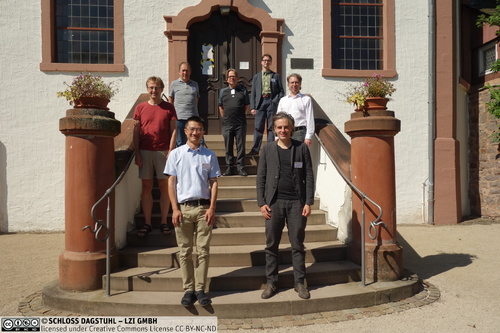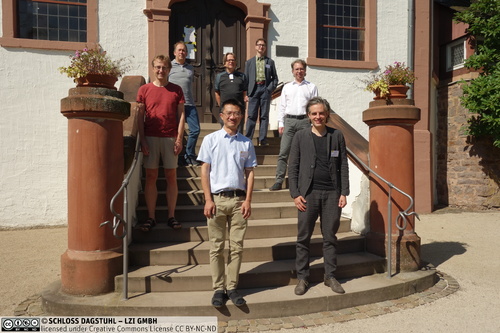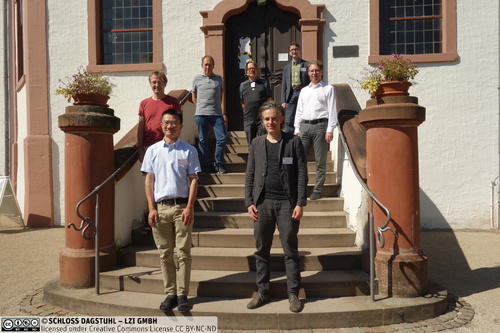Dagstuhl Seminar 21362
Structure and Learning
( Sep 05 – Sep 10, 2021 )
Permalink
Organizers
- Tiansi Dong (Universität Bonn, DE)
- Achim Rettinger (Universität Trier, DE)
- Jie Tang (Tsinghua University - Beijing, CN)
- Barbara Tversky (Columbia University - New York, US)
- Frank van Harmelen (VU University Amsterdam, NL)
Contact
- Shida Kunz (for scientific matters)
- Susanne Bach-Bernhard (for administrative matters)
Structure and learning are among the most prominent topics in Artificial Intelligence (AI) today. Structure is traditionally centered in symbolic AI, learning is currently centered in neural networks. How structures and learning can be integrated has been a grand challenge for decades. This Dagstuhl Seminar is intended to discuss the roadmap of the integration of structure and learning from an interdisciplinary perspective.
In this seminar, we will start with a talk about Mind in Motion, give examples on how cognitive collages are used for spatial thinking, and how abstract thinking is rooted in spatial thinking. We will then demonstrate how a novel explainable unsupervised neural network, equipped with a meta spatial structure, can rigorously carry out all types of syllogistic reasoning. This introduces a new perspective to the relation between symbolic AI and connectionist AI. We will revisit the two competing and complementary AI paradigms, showing that each simulates one aspect of the mind, System 1 and System 2. Recent progress in geometrical embeddings, either hyperbolic, euclidean, or neural, has shown that structures can be precisely embedded as spatial relations among ball embeddings, while features learned by neural networks can be represented as axis vectors around which balls can rotate (ball in motion). We plan to discuss Cognitive Graph — a form of neuro-symbolic AI, the cognitive System 1 corresponds to the machine learning-based AI and the System 2 corresponds to symbolic-based AI. This will shape “the third-generation of AI” with merits of both symbolic AI and neural networks: explainable, reliable, rigorous, robust, safe, and trustworthy. These features separate “the third-generation of AI” from direct neural-symbolic integration that builds rough bridges between symbolic and subsymbolic worlds. Machine learning will be dedicated to acquiring geometric embeddings from the triad of knowledge (background or interactive knowledge), data (ranging from sensors, to texts, audio, and images), and computing architectures, and realizes a human-centered AI ecosystem. It constructively learns a universe of vectors, static or rotating manifolds in an embedding space, solves problems that neither symbolic AI approach nor neural approach can solve alone, and finally realizes Motion in Mind of Machines, which, together with Mind in Motion, schematize a collage of hybrid human-machine intelligence (Hybrid Intelligence).
We will discuss research questions in a variety of fields of AI, Computer Science, and Cognitive Science, such as Knowledge Graph Reasoning, Natural Language Understanding, Computational Humor, Formal Ontologies, Qualitative Spatial Representation (QSR), Semantic Web, StarAI, Software Engineering, IoT, Computer Vision, and Robotics.
 Tiansi Dong, Achim Rettinger, Jie Tang, Barbara Tversky, and Frank van Harmelen
Tiansi Dong, Achim Rettinger, Jie Tang, Barbara Tversky, and Frank van Harmelen
Deep Learning systems are the hope of the fifth industrial revolution. However, recent studies have found that Deep Learning systems can be easily manipulated, i.e. in Natural Language Understanding, Object Recognition. How to introduce structures into Deep Learning systems to improve reliability and performance has become a hot topic in Natural Language Processing (NLP), Machine Learning (ML), Semantic Web (SW) communities around the world. The aim of the seminar is to bring together interdisciplinary researchers around the world for constructive discussions on this theme, in particular, it intends to establish international collaborations to promote computational Humor, with the hope to let AI bring more joy, more laugh into the world, and do more good for the society.
The hybrid seminar is structured in the form of Talks, Working Groups, and Open questions. The seminar started with the talk "Hybrid AI for Humor". The dynamic semantics of humor is beyond the reach of the classic symbolic AI, the deep learning paradigm, and current neural-symbolic integration methods, but can be captured by the neural geometric embedding, in terms of rotating sphere embedding. This novel embedding is rooted in Qualitative Spatial Representation (QSR) in symbolic AI and Learning Representation (LR) in neural ML. The former tries to symbolically delineate the basic spatial knowledge that humans have and possible ways that this knowledge can be used as a reference for abstract knowledge in other domains. LR aims at learning latent feature knowledge from data. The motivation and a geometric approach to realizing the unification were introduced in the talk "Rotating Spheres - A New Wheel for Neuro-Symbolic Unification". The motion of rotating spheres in high-dimensional space is served as a computational model to simulate (1) the motion of the physical world, (2) the circular interaction among the mind, the body, and the world (called spraction - a contraction of space, action, and abstraction, in which actions in space create abstractions).
The motion of the physical world is vividly explained in the talk "Rotating Spheres in the Milky Way". This spraction process is explained in the talk ``Thinking with the Body and the World'', which can guide the design of novel cognitive robots, and promote novel cognitive architectures. Two topics were covered by the talk "Learning about Language and Action for Robots", and the talk "Neural-Symbolic Models, Dual-Process Theories, and Cognitive Architectures".
In primates, the same brain structures that support spatial thinking also support conceptual thinking, Single cells in hippocampus gather multi-media information from different memories in the brain to represent places in space, events in time, ideas in conceptual spaces. Update-to-date research of neural simulation is introduced by Volker Tresp with the talk "Knowledge Graph and Cognitive Learning: from Perception to Memory Embedding", which maps embedding models to various cognitive memory functions, in particular to semantic and concept memory, episodic memory, sensory memory, short-term memory, and working memory.
Spatial thinking is multi-modal and established and distorted by our actions and perceptions of the spaces we interact in. This raises two questions: What are good representations for video understanding? and how to compute symbolic rules that the models have learned from the training data? Juergen Gall introduced holistic video understanding and argued the potential of hybrid approaches that combine neural networks with symbolic AI for video understanding and reasoning. Cuenca Grau, Bernado gave the talk "Characterizing Graph Neural Networks Using Logical Rules". He formally defines what it means for a set of logical rules to characterize the behavior of a model and proposes a GNN-based architecture that admits a characterization in terms of Datalog rules.
Spatial thinking is evident in the ways we think and the ways we externalize thought, for example, through words. Our words act on thought the way we act on objects. The philosophy of spatial thinking challenges the computational approach to natural language processing and understanding. Roberto Navigli argued that Natural Language Understanding (NLU) is particularly challenging, as this requires the machine to go beyond processing strings to reach a semantic level. Recent developments and challenges were discussed through three key tasks in NLU, namely Word Sense Disambiguation, Semantic Role Labeling, and Semantic Parsing. Zhiyuan Liu argued that knowledge (including symbols, embeddings, or models) is the key to a deeper understanding of human languages and that big pretrained language models can be regarded as the most advanced approach to model knowledge and to capture knowledge (including commonsense) from plain text and that the key challenge is how to incorporate both open data and structural knowledge. Alexander Mehler reviewed problems of neural network-based language learning, suggested to introduce the concept of cognitive maps and spatial information processing, and sketched a synergistic model that relates the dynamics of distributed information processing to bias interaction. Jie Tang introduced Wu-Dao, China's first homegrown super-scale intelligent model system, with the goal of building an ultra-large-scale cognitive-oriented pretraining model to focus on essential problems in general artificial intelligence from a cognitive perspective. Wu-Dao substantially outperforms BERT on the SuperGLUE natural language understanding benchmark with the same amount of pre-training data. Alam Mehwish discusses the characteristics of the existing benchmark datasets for the task of KG Completion, and limitations of the existing benchmark datasets and targets those issues in the generation of LiterallyWikidata.
Another externalization of spatial thinking is through graphics. In the talk "Semi-Riemannian Graph Convolutional Networks", Steffen Staab introduced their new geodesic tools that allow for extending neural network operations into geodesically disconnected semi-Riemannian manifolds. Thomas Liebig introduced using p-adic coding and computation for structured domains or domains with inherent granularity.
The ultimate form of spatial thinking is comics (a form of humor, the most creative form of storytelling), which typically show bodies acting in space. Humor is used as a testbed and lighthouse for the development of AI and machine learning. In the talk "Ethics of AI Humor" Kiki explained how humor has frustrated symbolic and statistic AI approaches; in the talk "Knowledge and Inferences Needed for Humor" Julia Rayz introduced recent advances in transformer-based approaches, and raised open questions.
Working groups are the main components of the seminar. The hybrid seminar provides an excellent chance to practice the situation that participants can continue to work together after this seminar, which is the main outcome of this seminar.
The seminar ended with the discussion "Boxology for Hybrid Learning and Reasoning Systems" chaired by Frank van Harmelen.
 Tiansi Dong, Achim Rettinger, Jie Tang, Barbara Tversky, and Frank van Harmelen
Tiansi Dong, Achim Rettinger, Jie Tang, Barbara Tversky, and Frank van Harmelen
- Tiansi Dong (Universität Bonn, DE) [dblp]
- Thomas Liebig (TU Dortmund, DE) [dblp]
- Alexander Mehler (Goethe-Universität - Frankfurt am Main, DE) [dblp]
- Sven Naumann (Universität Trier, DE) [dblp]
- Achim Rettinger (Universität Trier, DE) [dblp]
- Steffen Staab (Universität Stuttgart, DE) [dblp]
- Volker Tresp (Siemens - München, DE) [dblp]
- Mehwish Alam (FIZ Karlsruhe, DE) [dblp]
- Christian Bauckhage (Fraunhofer IAIS - Sankt Augustin, DE) [dblp]
- Sven Behnke (Universität Bonn, DE) [dblp]
- Jian-Jia Chen (TU Dortmund, DE) [dblp]
- Anthony Cohn (University of Leeds, GB) [dblp]
- Armin B. Cremers (Universität Bonn, DE) [dblp]
- Bernado Cuenca Grau (University of Oxford, GB)
- Asja Fischer (Ruhr-Universität Bochum, DE) [dblp]
- Xiaoming Fu (Universität Göttingen, DE) [dblp]
- Jürgen Gall (Universität Bonn, DE) [dblp]
- Christian Hempelmann (Texas A&M University - Commerce, US) [dblp]
- Mateja Jamnik (University of Cambridge, GB) [dblp]
- Markus Knauff (Universität Gießen, DE) [dblp]
- Michael Kramer (MPI für Radioastronomie, DE) [dblp]
- Jens Lehmann (Fraunhofer IAIS - Dresden, DE) [dblp]
- Juanzi Li (Tsinghua University - Beijing, CN) [dblp]
- Pietro Lio (University of Cambridge, GB) [dblp]
- Yong Liu (Outreach Corporation - Seattle, US) [dblp]
- Zhiyuan Liu (Tsinghua University - Beijing, CN) [dblp]
- Xiaoxing Ma (Nanjing University, CN) [dblp]
- Tristan Miller (OFAI - Wien, AT) [dblp]
- Siba Mohsen (Universität Bonn, DE)
- Adithya Murali (University of Illinois - Urbana-Champaign, US) [dblp]
- Roberto Navigli (Sapienza University of Rome, IT) [dblp]
- Max Petrenko (Amazon Web Services - Seattle, US) [dblp]
- Julia Rayz (Purdue University - West Lafayette, US) [dblp]
- Ron Sun (Rensselaer Polytechnic - Troy, US) [dblp]
- Jian Tang (Mila - Montreal, CA) [dblp]
- Jie Tang (Tsinghua University - Beijing, CN) [dblp]
- Barbara Tversky (Columbia University - New York, US) [dblp]
- Frank van Harmelen (VU University Amsterdam, NL) [dblp]
- Ran Yu (Universität Bonn, DE) [dblp]
Classification
- Artificial Intelligence
- Machine Learning
- Symbolic Computation
Keywords
- neural-symbol unification
- knowledge graph
- machine learning




 Creative Commons BY 3.0 DE
Creative Commons BY 3.0 DE
